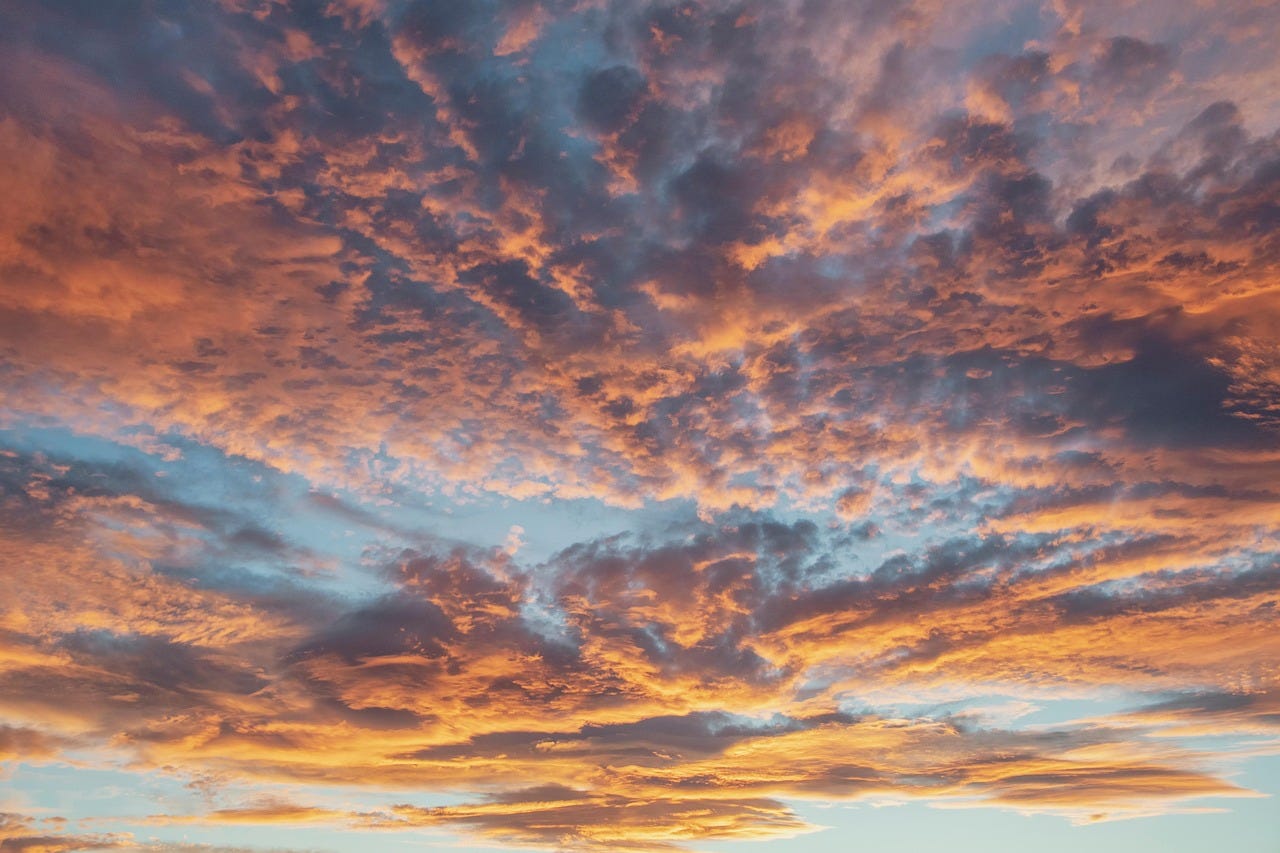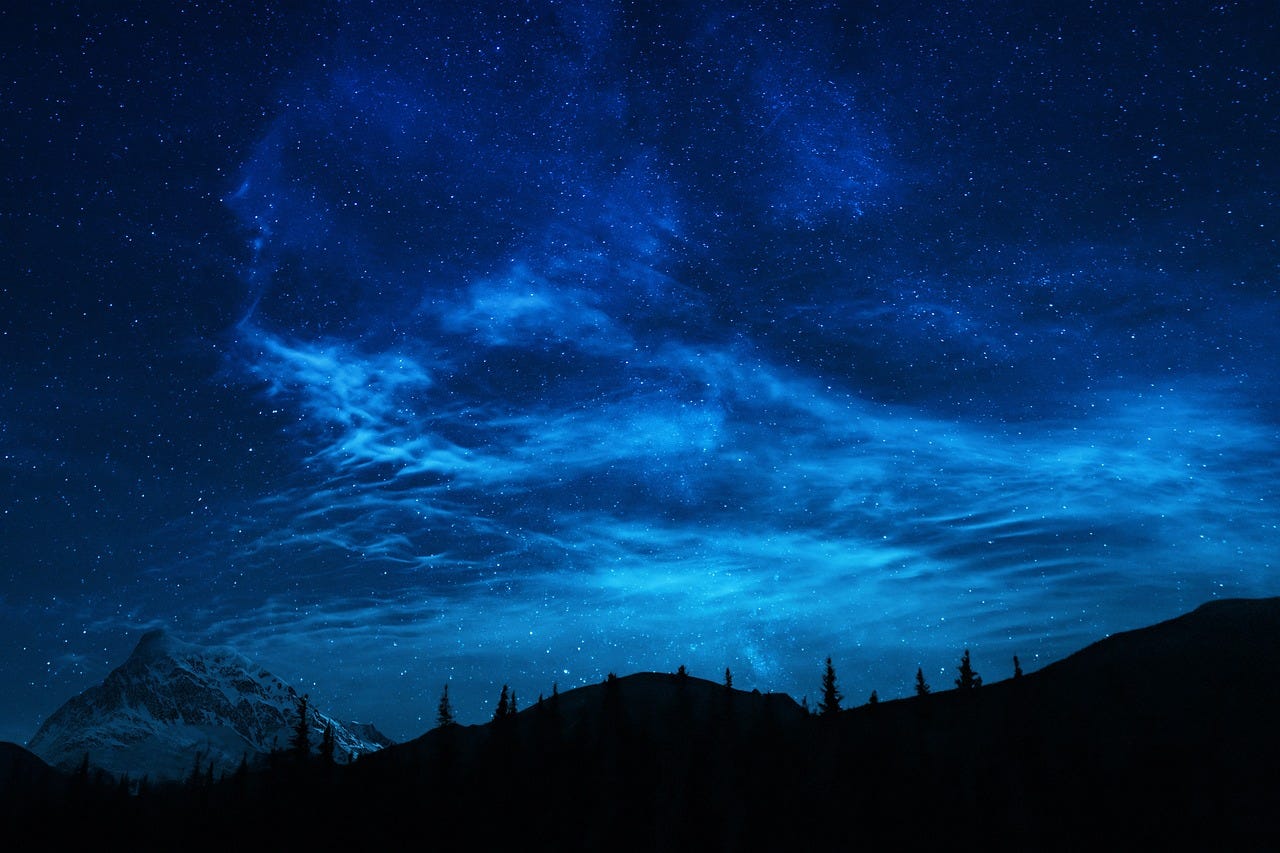Hello, my fellow wildling. It's good to spend time with you again!
Here in the Northern Hemisphere, it's the season of reawakening. 🌷
The air is softer. The light stretches longer each day. The world, once hushed in winter’s stillness, stirs again.
We step outside more often. We lift our faces to the sun. We see the sky, free of snow-laden clouds.
And that simple act of looking up does more for our nervous systems than we realize.
Skyward Eyes, Calmer Minds
Something changes inside us when we lift our gaze to the horizon or further into the sky. And science agrees: upward gazing calms us.
Researchers studying eye movement and posture have found that looking up—especially at open, expansive scenes—can increase our sense of spaciousness, reduce rumination, and even activate the parasympathetic nervous system, inviting calm.
An upward gaze pulls us out of the hunched posture we often hold during stress, scrolling, or problem-solving. It interrupts spirals of negative thought and gives the brain something wide and unthreatening to take in.
The sky holds no clutter. No to-do lists. No newsfeeds. No deadlines. No grades. No performance reviews. No demands.
Just color and cloud, dark and light.
Your Brain Loves the View
Let's dig a bit deeper into the neuroscience of looking up.
Our brains perceive what's below the horizon differently than what's above the horizon.
The world we see around us at eye level is viewed through one of our brains' visual systems in a specific way. The world around us is reachable. It's where our needs are met. It's also where the majority of threats present themselves.
Above the horizon, however, is more abstract.
Neuroscientist Fred Previc talks about a second visual system in our brain that specializes in looking at this space above the horizon. In his book, The Dopaminergic Mind in Human Evolution and History, he explains that this area of the brain is activated during...
🌟Religious or spiritual experiences
🌟Meditative states
🌟Dreaming
...among other activities that pluck us from the mundane and place us beyond our concepts of time and space.
Pause and consider this question: Can you think of any religious images, spiritual practices, or meditative or creative pursuits that involve looking up?
And...
☀️Have you ever turned your head upward when praying or meditating?
☀️Have you been moved to photograph a sunset?
☀️Have you energized yourself by watching the sunrise?
☀️Have you looked in awe at the brilliance of the night sky?
☀️Have you found your eyes drifting up to see what towers over you in a forest or a city?
Gazing at the horizon and above makes us feel simultaneously large—a part of something unfathomably big—and incredibly small. We exist in the cosmos, belonging to the universe, but we're also a speck among many other creations in that vast space.
There's something comforting about being both immense and tiny. There’s a balance of power and vulnerability that we often miss unless we look up.
Let the Light Lead You
For most of us, this season of longer days and more light supports the body’s natural circadian rhythm—the internal clock that governs sleep, energy, and mood.
Morning light, especially sunlight, is one of the best ways to reset that clock. Light exposure within the first 1-2 hours of waking helps regulate melatonin (the sleep hormone) and cortisol (the alertness hormone), both of which play a big role in emotional well-being.
This doesn't mean staring directly at the sun. (Please don’t!) It also doesn't mean spending hours in direct sunlight. (If you do, remember sunscreen!)
It simply means: Step outside. Let your eyes and skin drink in the sky. You don’t even have to do anything else. Just be there for a few moments. The light will touch you.
The sky is one of the few places we can return to again and again and never see things the same way twice.
“The sky is an infinite movie to me. I never get tired of looking at what's happening up there.” - K. D. Lang.
Becoming the Sky
The Whispering Wilds method always asks: What can nature teach us? How can we mirror its wisdom in our daily lives?
When we become the sky, we embrace a profound mindset.
✨The sky teaches us about impermanence, softness, and spaciousness.
✨Stars remind us we’re part of something significant.
✨Sunrises say: You made it to another day.
Clouds remind us that transformation is constant. ☁️They're forever changing shape. Sometimes, they seem absent. Other times, they're all we see on grey days or during storms.
How would we handle change in our lives if we were clouds? How can we envision ourselves as clouds through meditation, movement, creativity, or play?
Let your inner world mirror the sky. Watch how your emotions shift like clouds. Allow that shift to be okay. Allow things to pass.
When life feels heavy, look up. You are held by something vast.
Find Your "Sky State"
Here's something simple you can try to make the most of looking up in any season:
Step outside in the morning. Remember, the ground holds you securely.
Look up at the sky. Name three things you see, including objects (like clouds, birds, or celestial objects), colors, and textures.
Take five slow breaths while gazing up. Exhale longer than you inhale for maximum calming benefits.
Pay attention to how your mind reacts. Do you find yourself curious or creative? Or peaceful?
Notice how your body responds. Do you feel more grounded? Or lighter?
You might even recognize the “sky state”—a feeling of expanded awareness that comes from holding the sky in your vision and your mind.
Where My Eyes Go, I Grow
When I was a child, I traced cloud shapes with my fingers. That was my "meditation" before I ever learned the word.
As an adult, I lift my eyes constantly. It's one way I keep in touch with my crow family, and I laugh to see them zooming through the sky in playful flight on breezy days. I delight in the smallest crow flapping her beautiful wings furiously to keep up with her adopted sibling raven as he barrel rolls beside her.
🌙I whisper thanks to the moon for shining on my loves.
🌙I share my gratitude with the sun for her warmth.
🌙I watch the light move through the trees as the sun sets.
🌙I track Orion's journey across the sky in winter.
🌙I look for Ursa Major to guide me when I feel lost.
🌙I marvel at the bats deftly hunting at twilight.
🌙I follow firefly beacons in summer.
🌙I am enthralled by shooting stars and planets.
Looking up reminds me that I am not alone. It reminds me to slow down. To declutter my mind. To belong.
"For my part, I know nothing with any certainty, but the sight of the stars makes me dream." -Vincent Van Gogh
Look Up to Lighten the Load
If you’ve been feeling heavy, stuck, or anxious lately, don't forget:
You were not made to live your life looking down.
You were made to rise and meet the sky.
We share a sky, you and I. Let's meet here again soon. 🌿
Dina
If you enjoy The Whispering Wilds and feel moved to help, tips are always appreciated and keep this space thriving. ✨
Want to share this publication with others?
Please Note...
The Whispering Wilds method is not a replacement for medical and mental health care. Alternative health and wellness shines when it complements modern medicine, just as I believe modern medicine is at its best when accompanied by a holistic perspective. If you have a heart, lung, or circulatory condition, or suspect you do, or if you have a mental health disorder, or suspect you do, please ask your doctor or therapist before beginning any wellness practice.
Breathwork, meditation, journaling, movement, and other practices in The Whispering Wilds aren't suitable for everyone. The good news is that if your doctor or therapist advises you against a particular practice, the Whispering Wilds method will likely present alternatives to explore. Always ask your medical or mental health professionals first because we are all complex, unique individuals, and no true wellness approach is one-size-fits-all.






